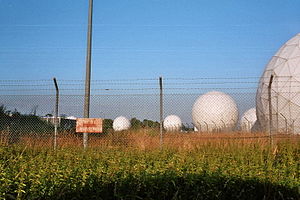Bad Aibling Station
| Bad Aibling Station | |
|---|---|
| Part of National Security Agency (NSA) | |
| Located in Bad Aibling, Bavaria, Germany | |
 Radomes of Bad Aibling Station | |
| Lua error in Module:Location_map at line 526: Unable to find the specified location map definition: "Module:Location map/data/Deutschland Bayern" does not exist. | |
| Type | Communications & Intelligence |
| Height | 492 m (1614 ft) |
| Site information | |
| Open to the public | no |
| Condition | dismantled, parts still in use |
| Site history | |
| Built | 1936/1952 |
| In use | 1952-2004 |
| Demolished | 2004 |
The Bad Aibling Station (abbreviated BAS, also known as Field station 81, which had an official designation as the 18th United States Army Security Agency Field Station, or as the pseudonym Hortensie III) is a satellite tracking station operated by the German intelligence agency Bundesnachrichtendienst (BND) in Bad Aibling, Bavaria.[1]
Created by the Western Allies in 1947, it was run by the U.S. National Security Agency (NSA) until the early 2000s, when operations were gradually transferred to the BND due to public outrage over U.S. surveillance operations in Germany.[2]
As part of the global surveillance network ECHELON, Bad Aibling is the largest listening post outside Britain and the USA.[3]
History
In 1936 a military airfield was established by the German National Socialist government on the site of a sport airfield in Bad Aibling-Mietraching.[4] After the Second World War, troops of the United States Army seized the military airport ("Fliegerhorst" and flight training base) that had evolved from the airfield. Initially, it was used by the occupying Americans as a camp for prisoners of war, a displaced persons camp, and as an orphanage under supervision of the UNRRA. Günter Grass and Joseph Ratzinger, later Pope Benedict XVI, are alleged to have met there as prisoners.[5]
In 1952, the area was taken over by the US Army. Since a four-power agreement enacted Austria's neutrality in 1955 US listening devices that were situated there had to be abandoned. They were relocated to Bad Aibling and during Cold War the field station 81 was converted by the United States Army Security Agency ("ASA") to a central communications monitoring station for American intelligence.[6]
In 1971 the National Security Agency (NSA) and the United States Department of Defense took over command from the U.S. Army. Simultaneously, the Army Security Agency transferred most of its activities in West Germany from its field stations located at Rothwesten, Bad Aibling and Herzogenaurach to Augsburg.
In 1994, the NSA transferred command of its Bad Aibling base to INSCOM, one of the Central Security Services of United States.[7]
After the end of the Cold War, on several occasions including investigations of the European Parliament that censured industrial espionage by American secret services, the Americans intended to close the Bad Aibling Station.[8] The September 11, 2001 attacks delayed these plans.
In the vicinity in Bad Aibling, a base of the Bundesnachrichtendienst (BND) has always been in existence within the area of former barracks of the Bundeswehr. The restructuring of the American intelligence community after the September 11, 2001 caused the closure of Bad Aibling Station on September 30, 2004. The base was returned to the Federal Republic of Germany. Information uncovered by Der Spiegel in 2013 from the Edward Snowden leaks indicated that the NSA continues to have a presence at Bad Aibling (Operation Eikonal), supported by the BND. The NSA functions are housed in a metal-clad building known colloquially as the "Tin Can".[9]
Institutions (as known)

- Different divisions of NSA (details not known)
- TASCOM, APO 09108 / 09098 - Carl Mosher[10] 1972 & 1973
- HOC 718th Military Intelligence Brigade
- C COMPANY 66th Military Intelligence Group, (formerly assigned to Augsburg, which closed in 1997;BRAC realignment)
- Air Force-402ND Intelligence Squadron
- 108th Military Intelligence Group (former designation: 718th MI Group)
- Navy-NSGA (Naval Security Group Activity)
- 18th USASAFS Field Station
- 312th ASA Battalion
- 320th ASA Battalion
- Headquarters Company
- 180th ASA Company
- 181st ASA Company
- 186st ASA Company
- 402nd Intelligence Squadron[11]
- British Royal Signals Detachment (UK)
Significance for secret services
The Bad Aibling Station was an important monitoring station of the ECHELON System (RSOC, Regional SIGINT Operation Center) that employed up to 1000 staff members. Its task was acquisition of information for American authorities and other closely allied intelligence services, e.g. from the United Kingdom. The López affair that was cleared up by telephone surveillance in the BAS gained worldwide audience.
According to official statements, the function of BAS was "Rapid Radio Relay and Secure Common, Support to DoD and Unified Commands, Medium and Longhand Common HF & Satellite, Communication Physics Research, Test and Evaluate Common Equipment"[12]
Only few details are known. Serious hints, however, support the assumption that the BAS supervised numerous communication channels, including wireless communication, telephony and internet traffic. Particularly the communication with satellites, also outside the Intelsat system, seems to have been monitored by the BAS.[13]
-
Field Station 81
-
radome field
-
radome field
-
central area from south
Notes
- ^ Center for Cryptologic History: "Bad Aibling Station - A Legacy of Excellence"
- ^ David Ruppe. "U.S. to Close Eavesdropping Post". ABC News. Retrieved 21 December 2013.
- ^ Shafir, Reinhard Wobst ; translated by Angelika (2007). Cryptology unlocked. Chichester: John Wiley & Sons. p. 5. ISBN 0470516194.
{{cite book}}: CS1 maint: multiple names: authors list (link) - ^ History of the "Fliegerhorst" Mietraching at www.mietraching.de (in German)
- ^ open book: Ratzinger and Grass
- ^ OVB online: B&O-Gelände - einst und heute. Retrieved on September 16th, 2015
- ^ RAVEN: INSCOM in Bad Aibling (in German)
- ^ Yorkshire CND: Bad Aibling Station to close
- ^ Gude, Hubert; Poitras, Laura; Rosenbach, Marcel (August 5, 2013). "Mass Data: Transfers from Germany Aid US Surveillance". SPIEGELnet GmbH. SPIEGEL ONLINE 2013. Retrieved 2 June 2014.
- ^ Carl Mosher
- ^ Piper, Gerhard (2003). "Die strategische Bedeutung der US-Luftwaffenbasen in der BRD" (PDF). antimilitarismus information (3–4): 1–16. Retrieved 2016-08-09.
- ^ Official report on the existence of a global system for the interception of private and commercial communications (ECHELON interception system) for the European Parliament
- ^ European Union and FBI launch global surveillance system. A Statewatch report. 27 February 1997
References
- Message at military.com
- Information by US Army Security Agency Field Station Augsburg at the Wayback Machine (archive index)
- Video of a trip through the remainders of BAS in 2011 on YouTube—seven years after its closing and partly dismantling






